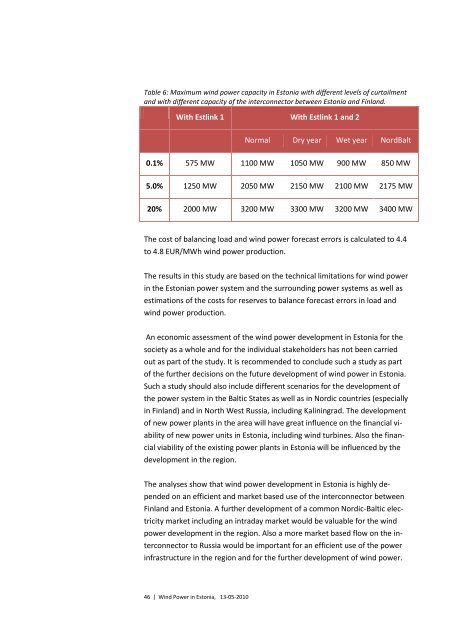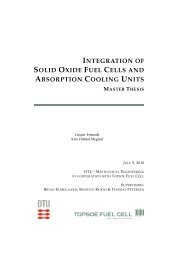Wind Power in Estonia - Elering
Wind Power in Estonia - Elering
Wind Power in Estonia - Elering
Create successful ePaper yourself
Turn your PDF publications into a flip-book with our unique Google optimized e-Paper software.
Table 6: Maximum w<strong>in</strong>d power capacity <strong>in</strong> <strong>Estonia</strong> with different levels of curtailmentand with different capacity of the <strong>in</strong>terconnector between <strong>Estonia</strong> and F<strong>in</strong>land.With Estl<strong>in</strong>k 1 With Estl<strong>in</strong>k 1 and 2Normal Dry year Wet year NordBalt0.1% 575 MW 1100 MW 1050 MW 900 MW 850 MW5.0% 1250 MW 2050 MW 2150 MW 2100 MW 2175 MW20% 2000 MW 3200 MW 3300 MW 3200 MW 3400 MWThe cost of balanc<strong>in</strong>g load and w<strong>in</strong>d power forecast errors is calculated to 4.4to 4.8 EUR/MWh w<strong>in</strong>d power production.The results <strong>in</strong> this study are based on the technical limitations for w<strong>in</strong>d power<strong>in</strong> the <strong>Estonia</strong>n power system and the surround<strong>in</strong>g power systems as well asestimations of the costs for reserves to balance forecast errors <strong>in</strong> load andw<strong>in</strong>d power production.An economic assessment of the w<strong>in</strong>d power development <strong>in</strong> <strong>Estonia</strong> for thesociety as a whole and for the <strong>in</strong>dividual stakeholders has not been carriedout as part of the study. It is recommended to conclude such a study as partof the further decisions on the future development of w<strong>in</strong>d power <strong>in</strong> <strong>Estonia</strong>.Such a study should also <strong>in</strong>clude different scenarios for the development ofthe power system <strong>in</strong> the Baltic States as well as <strong>in</strong> Nordic countries (especially<strong>in</strong> F<strong>in</strong>land) and <strong>in</strong> North West Russia, <strong>in</strong>clud<strong>in</strong>g Kal<strong>in</strong><strong>in</strong>grad. The developmentof new power plants <strong>in</strong> the area will have great <strong>in</strong>fluence on the f<strong>in</strong>ancial viabilityof new power units <strong>in</strong> <strong>Estonia</strong>, <strong>in</strong>clud<strong>in</strong>g w<strong>in</strong>d turb<strong>in</strong>es. Also the f<strong>in</strong>ancialviability of the exist<strong>in</strong>g power plants <strong>in</strong> <strong>Estonia</strong> will be <strong>in</strong>fluenced by thedevelopment <strong>in</strong> the region.The analyses show that w<strong>in</strong>d power development <strong>in</strong> <strong>Estonia</strong> is highly dependedon an efficient and market based use of the <strong>in</strong>terconnector betweenF<strong>in</strong>land and <strong>Estonia</strong>. A further development of a common Nordic-Baltic electricitymarket <strong>in</strong>clud<strong>in</strong>g an <strong>in</strong>traday market would be valuable for the w<strong>in</strong>dpower development <strong>in</strong> the region. Also a more market based flow on the <strong>in</strong>terconnectorto Russia would be important for an efficient use of the power<strong>in</strong>frastructure <strong>in</strong> the region and for the further development of w<strong>in</strong>d power.46 | <strong>W<strong>in</strong>d</strong> <strong>Power</strong> <strong>in</strong> <strong>Estonia</strong>, 13-05-2010
















